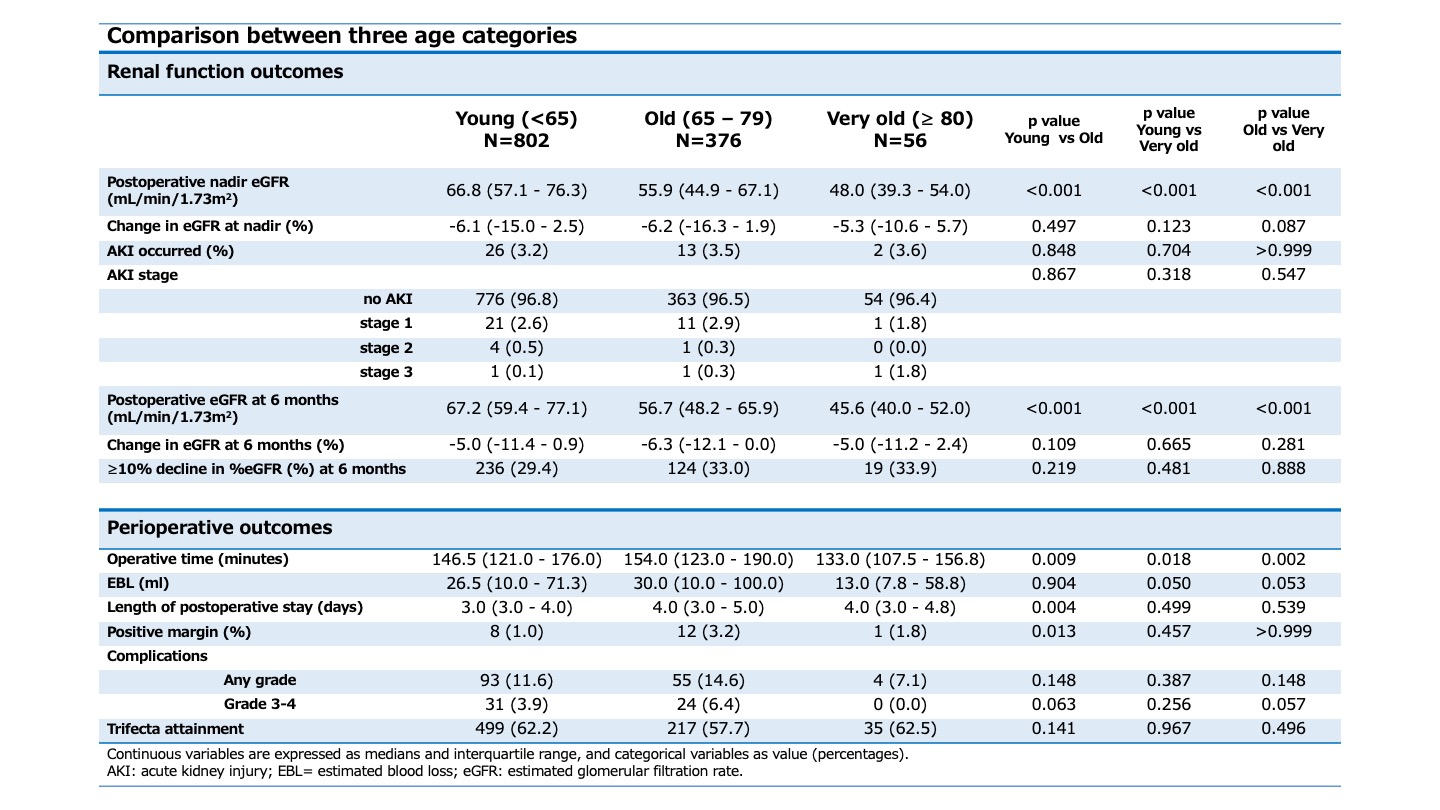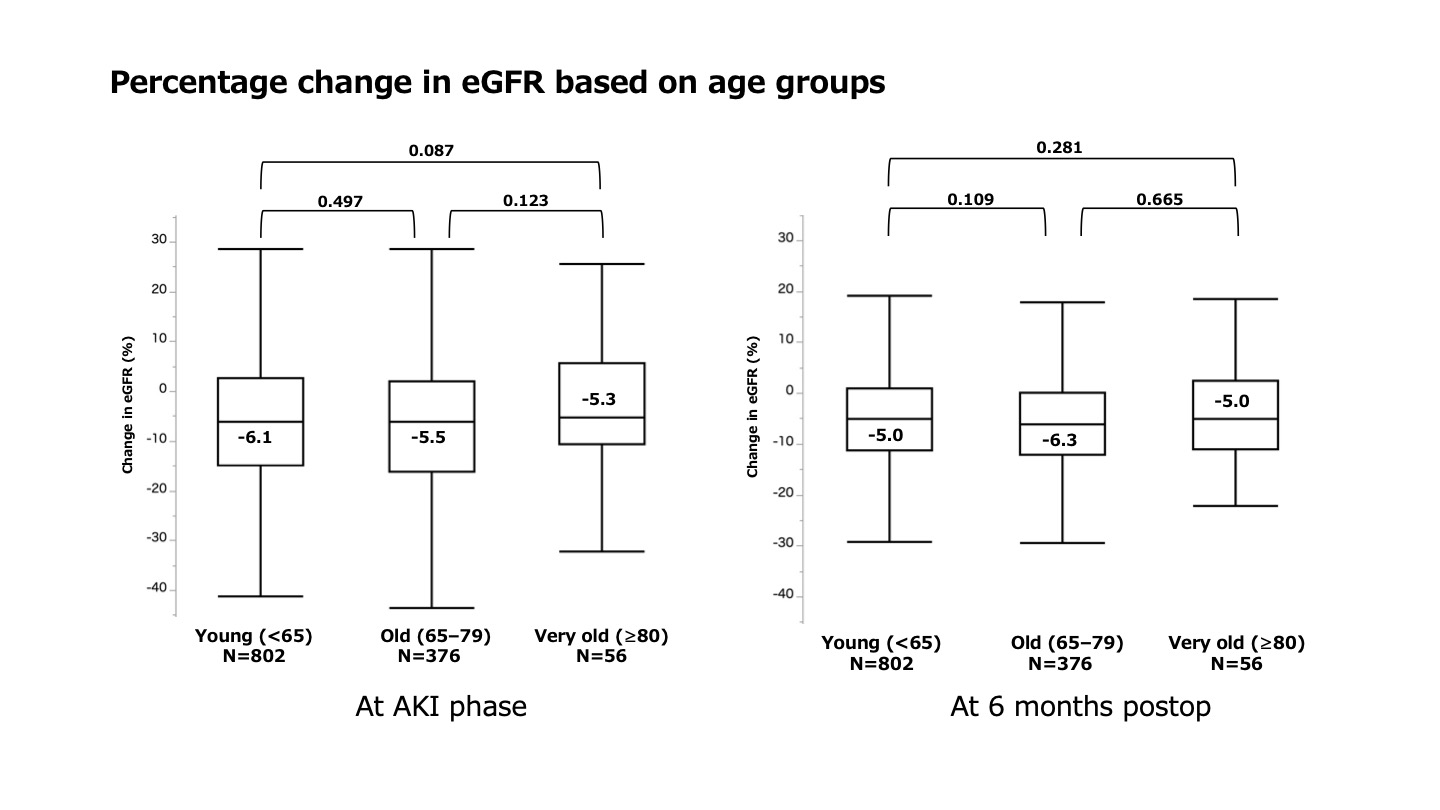Back
Poster, Podium & Video Sessions
Moderated Poster
MP50: Kidney Cancer: Localized: Surgical Therapy III
MP50-18: Efficacy and feasibility of robot-assisted partial nephrectomy for octogenarians: comparison with younger counterparts
Sunday, May 15, 2022
4:30 PM – 5:45 PM
Location: Room 225
Yudai Ishiyama*, Tsunenori Kondo, Arakawa, Japan, Kazuhiko Yoshida, Junpei Iizuka, Kazunari Tanabe, Toshio Takagi, Tokyo, Japan

Yudai Ishiyama, MD
Tokyo Women's Medical University
Poster Presenter(s)
Introduction: Evidence regarding robot-assisted partial nephrectomy (RAPN) for the elderly is scarce and data regarding the comparison across different age groups are rare. The aim of this study is to compare short-term functional and surgical outcomes of robot-assisted partial nephrectomy (RAPN) in patients =80 years old and their younger counterparts.
Methods: We retrospectively analyzed 1234 patients who underwent robot-assisted partial nephrectomy. The cohort was classified into three groups (Young [ < 65, N=802], Old [65 – 79, N=376], and Very old [= 80, N=56]) based on the age at the time of surgery. The perioperative outcomes, including acute/mid-term renal function, perioperative safety profiles, and trifecta attainment, were compared among the three groups.
Results: Preoperative estimated glomerular filtration rate (eGFR) was significantly lower in the Very old group (49.0 mL/min/1.73m2 ), compared to Young (71.6) or Old (60.9) (all, p <0.001). The decline in %eGFR at acute kidney injury (Young: -6.1 mL/min/1.73m2, Old: -6.2, Very old: -5.3; all, p>0.05) and occurrence of AKI (all, p>0.05) was comparable among groups. Similarly, change in %eGFR at 6 months was comparable across the three groups (Young: -5.0, Old: -6.3, Very old: -5.0; all, p > 0.05). Operative time and estimated blood loss were smaller in the Very old group compared to the Young or Old groups. Furthermore, there were no differences in trifecta attainment rates among the groups
Conclusions: RAPN for patients =80 years old showed comparable renal function and safety profiles compared to younger counterparts.
Source of Funding: None.


Methods: We retrospectively analyzed 1234 patients who underwent robot-assisted partial nephrectomy. The cohort was classified into three groups (Young [ < 65, N=802], Old [65 – 79, N=376], and Very old [= 80, N=56]) based on the age at the time of surgery. The perioperative outcomes, including acute/mid-term renal function, perioperative safety profiles, and trifecta attainment, were compared among the three groups.
Results: Preoperative estimated glomerular filtration rate (eGFR) was significantly lower in the Very old group (49.0 mL/min/1.73m2 ), compared to Young (71.6) or Old (60.9) (all, p <0.001). The decline in %eGFR at acute kidney injury (Young: -6.1 mL/min/1.73m2, Old: -6.2, Very old: -5.3; all, p>0.05) and occurrence of AKI (all, p>0.05) was comparable among groups. Similarly, change in %eGFR at 6 months was comparable across the three groups (Young: -5.0, Old: -6.3, Very old: -5.0; all, p > 0.05). Operative time and estimated blood loss were smaller in the Very old group compared to the Young or Old groups. Furthermore, there were no differences in trifecta attainment rates among the groups
Conclusions: RAPN for patients =80 years old showed comparable renal function and safety profiles compared to younger counterparts.
Source of Funding: None.



.jpg)
.jpg)